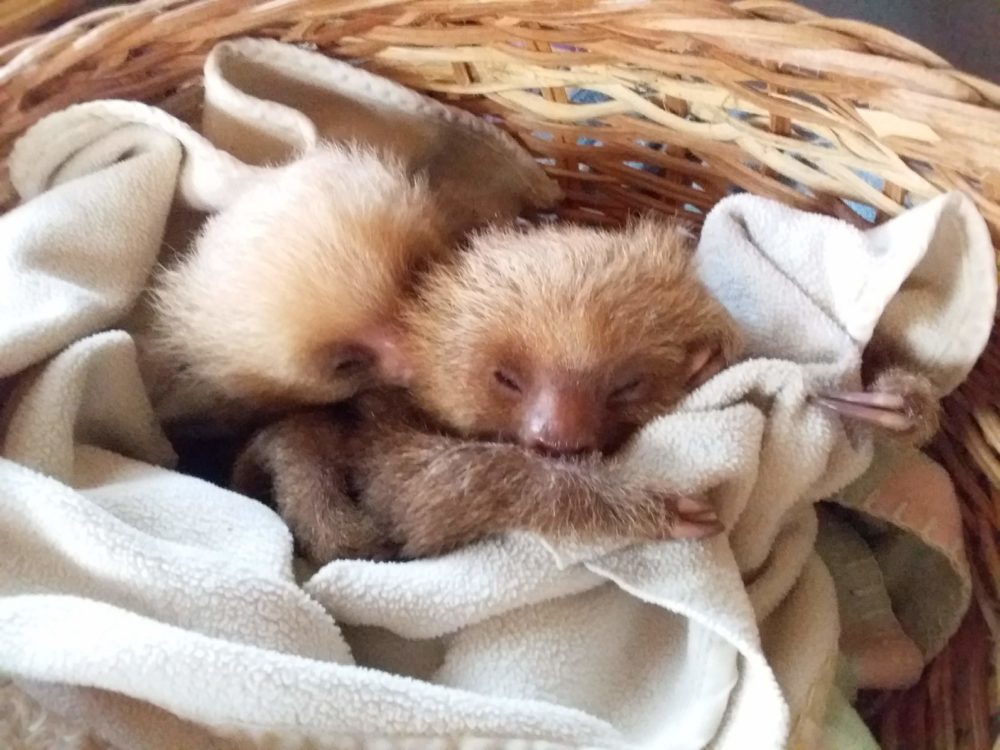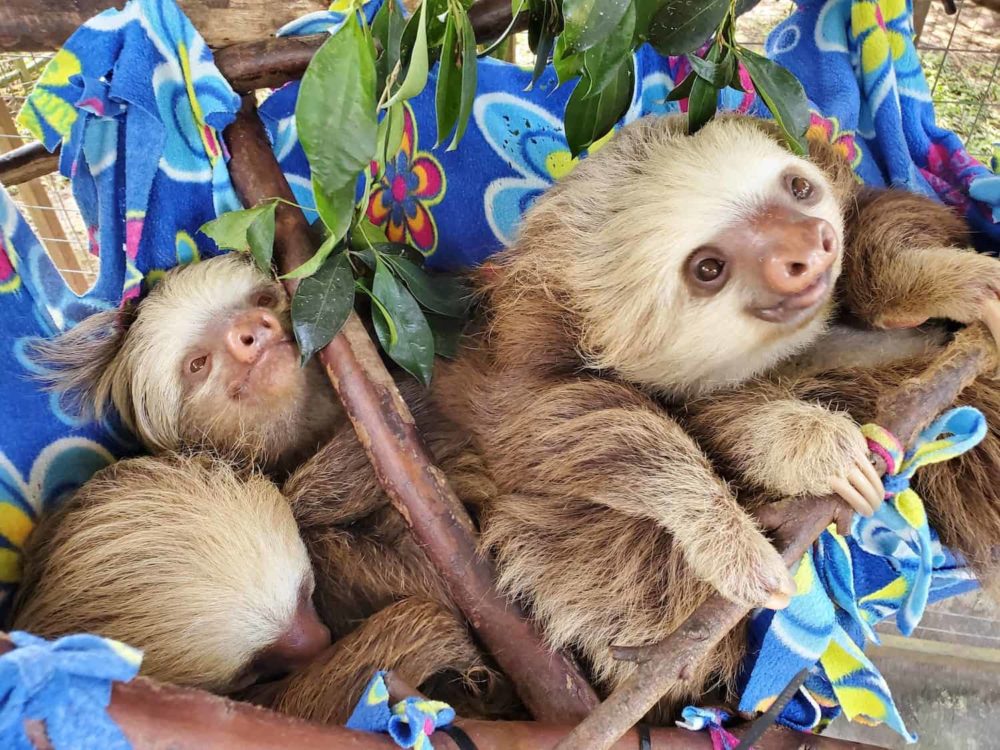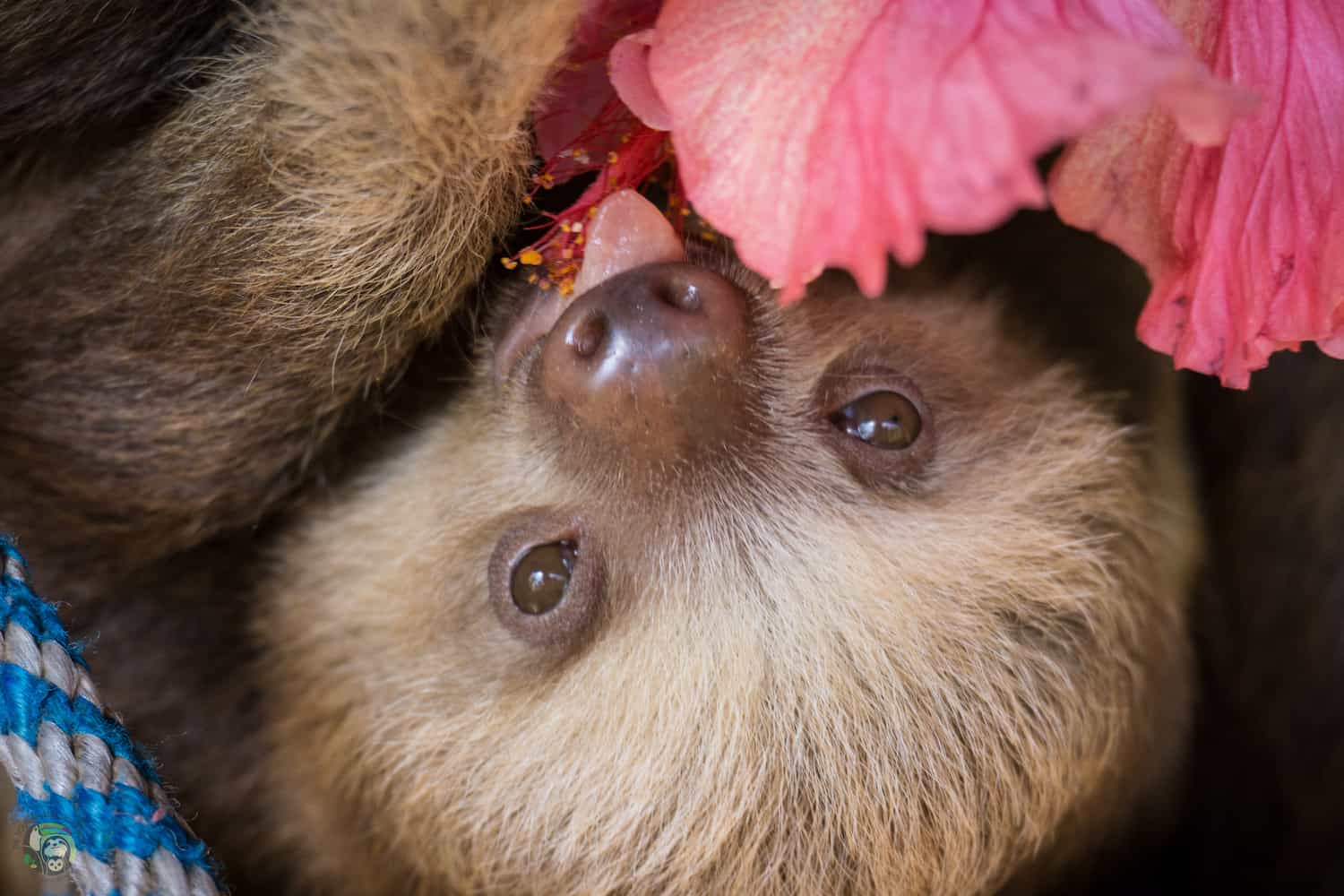In life, we say many goodbyes. While some are sad, others denote new beginnings and future opportunities. Such were the goodbyes that I said today, as I helped load three beautiful adolescent Hoffman’s two-fingered sloths into their travel kennel to make the hour-long trip to our Release Site in Sarapiquí. This was especially bittersweet yet exciting for me, as I helped hand-raised these three sloths, along with others who will be making the same trip next week.
When I think back on the last two years and my role in helping these orphaned sloths get a second chance at a life in the wild, I am filled with pride. I never imagined that as a retired zookeeper of many years, I would have the amazing opportunity of a lifetime, to do something like this. This whole experience came about back in early 2018 when I read that the Toucan Rescue Ranch in Costa Rica was looking for volunteers. Since I always felt that I still had a contribution to make to the animal world, I decided to go for it and applied for an internship.
The Toucan Rescue Ranch was originally founded by Leslie Howle to help rescue birds — with toucans being the focus. That original goal evolved over the subsequent years, as the need to help other native species became evident. It has since become a very well-respected, and much-needed, multi-species rescue facility.
With the growing number of sloths being injured, a program was implemented to not just rescue and rehabilitate, but to also release them back into the wild successfully. This is a very important program due to the sad fact that sloths — while being very solitary, shy creatures who prefer to stay hidden way up in the tree canopies — are still one of the most adversely impacted animals in Costa Rica. Human encroachment on their natural habitat has been devastating to sloths. If we can give them a second chance at life back in the wild, it helps mitigate what we humans have done to their natural environment.

At the Toucan Rescue Ranch, we receive many injured and orphaned sloths that we do manage to return to the trees in a relatively short amount of time. This can be accomplished if the injuries aren’t extensive and the sloth is an adult or adolescent, old enough to live on its own. In the case of young orphans, it is a much more lengthy process that can take a couple of years.
Two very different species of sloths live in Costa Rica: the Hoffmann’s two-toed (or two-fingered) Sloth and the Brown-throated three-toed or three-fingered Sloth. (All sloths have three toes, so two-toed is a misnomer.)
The majority of sloths that we receive are the lesser-known Hoffmann’s two-fingered sloth as opposed to the hugely popular three-fingered sloths, that seem to have taken the retail world by storm.
We receive more two-fingered sloths mainly due to being located in the central part of the country at a higher altitude, with cooler temperatures. The Hoffmann’s two-fingered sloths are a hardier, more active species than the three-fingered sloths, who have the slowest metabolism of any warm-blooded mammal. We do receive a few of those very slow enigmatic creatures in a year, and when they arrive, I will admit that I completely understand their appeal. They seem almost unreal. While they aren’t aggressive like the two-fingered sloths, in true sloth fashion, they want nothing to do with humans.
When I started my internship at the Toucan Rescue Ranch in early August 2018, I wasn’t sure what my role at TRR would be, but I was excited at the possibilities. I had been a zookeeper for 20+ years at a very well-known zoo and had hand-raised many species of birds and mammals. I soon discovered, much to my delight, that I would be the full-time sloth caregiver, living in the Sloth House, with the young sloths. I would be responsible for helping Leslie raise the newly arrived orphans. This was mainly due to my experiences raising lots of orphaned hummingbirds over many years. I soon discovered in the following months, how daunting a task raising baby sloths could be. People are always in awe of those of us who have raised baby hummingbirds, but I guarantee you they are much easier to raise than baby sloths.
When orphaned sloths arrive at our facility, they are examined by our veterinary team to assess their health status. If we are lucky we are given as much information available by the Environment Ministry (MINAE) so that we know the circumstances under which they were found. Was the mother killed by a dog, hit by a car, or electrocuted on a power line? Was the baby found abandoned? If a baby sloth is found alone, whether on the ground or a low tree branch, we don’t know the circumstances that caused it to be separated from its mother. Did it fall out of the tree? Is it sick? Did something happen to the mother?
Once the new arrival has been examined, and as long as there are not any extensive injuries, it goes to our sloth nursery, which is where my journey began two years ago. Back then, I never imagined what a challenging yet rewarding job it would be. Sloths are wild animals and even when hand-raised, remain so, which makes our job of releasing them back to the wild a much easier one.
The babies, if very young, are initially placed in small baskets or tubs with a soft nest of blankets, and an added heating element, since sloths, especially baby sloths, do not regulate their body temperature well. At this point, they are fed goat’s milk via a small syringe which requires great concentration so they don’t aspirate. I kid you not when I say that feeding baby sloths with a syringe is more difficult than feeding baby hummingbirds! I have the highest admiration for Leslie, who has dedicated her life to helping these little guys for so many years! It’s not an easy job.
Having gone through the trauma of losing their mother and in some cases, sustaining an injury, sloths usually arrive quite stressed, so our first job is to reduce external stimuli that might cause them more stress. They are kept in a quiet area, away from people except their caregivers. For caregivers, chemicals and strange smells can affect them so the use of any creams, sunscreen or bug spray is not allowed.
Sloths are wild animals through and through and can be quite aggressive, especially the Hoffmann’s two-fingered sloths. All sloths eat leaves, but Hoffman’s two-fingered sloths are folivores, which means that they could opportunistically eat some animal protein like insects, eggs, and maybe even an occasional lizard. For this reason, they — unlike their slower, leaf-eating counterparts — have four very sharp fang-like teeth in the front of their mouth and they’re not afraid to use them!
Imagine what it must be like for these poor little creatures who have been quietly riding on the bellies of their mothers way up in the tree canopy, when all of a sudden, their world is literally turned upside down. It’s only natural that they would try to defend themselves the only way they can, which is by biting and grabbing with their very sharp strong claws. They don’t follow that adage, “Don’t bite the hand that feeds you!” Hence, the use of small blankets and stuffed animals is highly recommended!
During my first week, I learned how to carefully feed and handle baby sloths, including a tiny one named Snickers. I was also trained in the fine art of pottying baby sloths, which is a very important part of their day.
As the weeks progressed, more babies arrived. Phoebe, Arya, and Rachel, all unrelated female two-fingered sloths, gave me even more opportunities to learn about baby sloths. Sadly, their mothers had all been killed by dogs. This is when the hard reality of what these poor animals deal with in their ever-changing environment hit me. While sloths prefer to stay in the tree canopy, they do climb down once a week or so to relieve themselves at the base of the tree before climbing back up. This is when they are most vulnerable to predators, with dogs being one of their biggest threats. Many times, people who find a sloth being attacked by a dog are too late to save the mother, but might be able to save the baby, sometimes even rescuing it from the dog’s mouth.
A month or so after the three girls arrived, we received our first little male sloth, who Leslie named Bon Jovi. He was a mess! A woman had bought him from a man on the streets of San José, and she took him home thinking he would make a great pet for her children. She learned very quickly that sloths do not make good pets — at all. She, fortunately, called the proper authorities, begging them to come to get this wild little creature, but not before she had fed him the wrong diet of cow’s milk, causing him to cry all night with horrible diarrhea. The poor thing needed lots of TLC before he could join the little girls.
About a month after this, Anise arrived. A fluffy poof of fuzziness, she arrived wet, cold, and dirty. She had been found crying at a river’s edge. These sloths and a few others made up our Sloth Elementary School classroom that I was in charge of, while Leslie took on the newborns and premature babies.
We have several phases to the sloth program, which mirrors the developmental stages that the sloths would be going through with their mothers in the wild. Two-fingered sloths generally stay with their mothers for about two years. Because sloths by nature do not play, we offer natural enrichment items to encourage typical behaviors. This begins in the Sloth Elementary phase and includes the placement of lots of branches and vines to climb on, plus fresh leaves to eat. At this age, they are offered cooked carrots, green beans, and at times scrambled egg, as they are being weaned from milk. We also on occasion give them hibiscus flowers as a special treat.

They stay in the Sloth House at night with hammocks for communal sleeping and structures for climbing, as they are nocturnal. During the day, they are out on a climbing structure with their buddies in their same age group. In the wild, they would not be with other baby sloths, but by having them together, they can cuddle each other, which gives them the sense of warmth and security they would be getting from their mothers.
By the time they are approaching their one-year mark, they are eating completely on their own and are becoming more interested in moving around. They are moved outside permanently, so they can also acclimate to the rain, as well as the fluctuating night and day temperatures. We call this phase our Sloth High School. At this point, even though they have been hand-raised, they are also becoming a bit more aggressive and independent. This is their last phase at the Toucan Rescue Ranch, before they “graduate” and move up to the Release Site, which is called Sloth University. There, they will spend their time in much larger pre-release enclosures and start breaking the bonds they have with each other as they transition to their solitary lifestyle. We use radio collars to allow our amazing sloth technicians to monitor our previously released sloths, and all of them are in use at the moment.
We’re hoping that as soon as things relax due to COVID-19 restrictions, we will be able to acquire more in time for the next group’s release, and when it’s their turn, the sliding gate is opened, and a whole new (old) world will be made available to them once again.
This is where my participation in this wonderful program has come full circle. It’s with great hope for success, and maybe a few tears, that I watch these beautiful animals that I spent so many hours with. They leave to continue their journey, one that almost didn’t happen — but for programs like Saving Sloths Together.
While COVID-19 has stopped the world in its tracks, nature continues its cycle, unaffected. We continue to receive more sloths and other animals in need of our services, and we do our best, but times are tough. If you are interested in donating to please consider symbolically adopting a sloth that’s in our care or donating to Toucan Rescue Ranch.
— Denise Gillen is an Animal Support Volunteer at Toucan Rescue Ranch.






